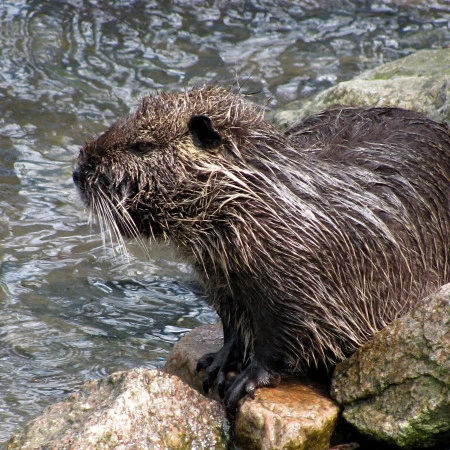Recipe by Chef Philippe Parola
Nutria:
1 ea Nutria Hind Saddle
2 qt Cold Water
1 cup Red Wine
1 tsp Red Wine Vinegar
1 tsp Hot Sauce of choice
To Taste Salt and Pepper
Pasta:
2 lbs Fettuccini (cooked)
3 ea Mushrooms, sliced
1 ea Garlic Clove, minced
1 Tbsp Sun-Dried Tomatoes
2 Tbsp Olive Oil
To Taste Fresh Spinach Leaves
To Taste Parmesan Cheese
1 ea Red Bellpepper, diced
Bouquet Garni:
1 ea Clove, whole
1/2 bunch Parsley
4 ea Black Peppercorns
Mire Poix:
1 ea Onion, chopped
1 ea Carrot, chopped
1 ea Celery Stalk, chopped
2 ea Garlic Cloves, chopped
Bring water, seasonings, mire poix and bouquet garni to a boil. Add nutria hind saddle and simmer for 1 hour or until meat is tender. Remove nutria meat and break meat off bones. Make sure to discard any gristle or silver skin.
With olive oil: saute garlic, sun-dried tomatoes, mushrooms, bell pepper, and spinach for 3 to 4 minutes. Add poached nutria meat and saute for 3 minutes until hot. Add fettuccine, saute then serve. Top with Parmesan cheese. Makes 4 servings.
Region of Origin: South America.  Habitat: Riparian (River Banks)
Habitat: Riparian (River Banks)
Current Range: Present on every continent except for Australia and Antarctica
Life Span: 3-4 Years in the Wild
Nutria, the infamous ‘river rat’, were introduced to the U.S. west coast as an alternative to mink in the mid-1900’s. Although 1.5 million nutria were trapped yearly for the fur trade in its heyday, nutria fur is no longer in fashion and wild populations have rocketed. A nutria female can potentially produce 3 litters a year, with up to 13 pups per litter. They are insatiable eaters that wreak havoc on riparian plants. Trapping is the best method for catching nutria. Bait live traps with sweet potatoes or carrots and place them along active trails. Despite looking like a giant rat, wild nutria are clean animals. They consume plants only and among the healthiest of meats to consume.
